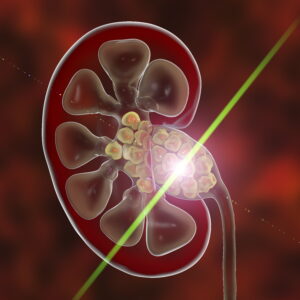Menu
Kidney stones are solid pieces of material that form when substances normally found in the urine, such as mineral and acid salts, become concentrated and crystallize. A stone can range in size from a grain of sand to as large as a golf ball. It may remain in the kidneys or travel down the urinary tract into the ureter. A small stone may pass on its own, causing little or no pain. However, a larger stone may get stuck along the tract and block the flow of urine, resulting in intense pain or bleeding.
Anyone can develop a kidney stone, but some people are more likely to get one.
Those with increased risk include:
Kidney stones do not always cause pain. If they do, the first sign can often be the sudden development of intense, unrelenting, and contraction-like pain in the side and back, below the ribs that spread to the lower abdomen and groin.
Other symptoms may include:
Tests and procedures to diagnose kidney stones include:
A lithotripsy is a medical procedure involved in removing kidney / bladder stones through the use of different processes. Kidney and bladder stones are solid pieces of material that form when substances normally found in the urine, such as minerals and acid salts, become concentrated and crystallized. These stones can grow up to the size of a golf ball. If the stone attempts to exit through the urinary tract, this may lead to immense pain and likely bleeding. Through the lithotripsy procedure, these stones are broken down through the use of laser or shock waves.
kidney / bladder stones through the use of different processes. Kidney and bladder stones are solid pieces of material that form when substances normally found in the urine, such as minerals and acid salts, become concentrated and crystallized. These stones can grow up to the size of a golf ball. If the stone attempts to exit through the urinary tract, this may lead to immense pain and likely bleeding. Through the lithotripsy procedure, these stones are broken down through the use of laser or shock waves.
Laser Lithotripsy is going to be the minimally invasive form of kidney/bladder stone removal. This procedure involves the use of an ureteroscope. The ureteroscope acts as a camera for your Urologist. He uses this camera to navigate through the urinary tract into the ureter or kidney. Once inside, he will locate the stone. The ureteroscope also acts as a tube for a fiver to extend out. This fiber creates a laser that will then breakdown the kidney or bladder stone. If necessary, a stent will then be placed within the ureter to protect it as the stones pass through. Once the stones have completely passed, your Urologist will remove the stent. This usually takes a few days to a couple weeks.
Effects of lithotripsy sometimes may be painful. You’re likely to see bleeding within your urine and pains within your lower abdomen. The best way to relieve pain is to drink large amounts of water and using some type of oral pain medication. If problems persist for more than a week such as continued bleeding, severe pain, or a strong feeling of needing to urinate, then contact your health care provider immediately. Although seldom, these kidney stones may cause bleeding near the kidney, a blockage within your urinary tract or possibly severe damage where the stone was residing.
Contact a medical professional at Z Urology if you have any of the following symptoms,



